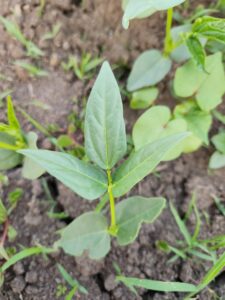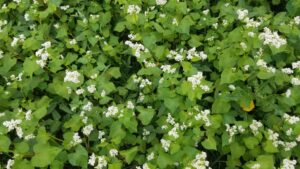Drought tolerance is top of everyone’s mind this year. Dry conditions and cover crops don’t always mix – they use precious moisture in dryland agriculture that’s rarely returned in a timely fashion. In irrigated agriculture, the expense of irrigating them might not be justified. However, there are cover crops that tolerate dry conditions and still give back, like cowpea.
Cowpeas (Vigna unguiculata) were likely first domesticated in Africa, though little is known about their exact origin. They get their English name from its history as a cattle fodder crop, but humans have been cultivating and eating cowpea for at least a few thousand years. Many cultivars exist, including the conspicuous black-eyed pea, which is primarily white with a circle of black coloration surrounding the seed’s hilum. Cowpeas spread throughout the world from West Africa. The slave trade introduced cowpea to North America. Cowpea production in the US peaked in the late 30s, with nearly 5.7 million acres planted nationwide. Today, production has fallen drastically to just under 13,000 acres. The drop in production is likely the result of myriad factors, including difficulty with pests, disease, plant architecture, and profitability. However, cowpea’s abilities to improve soil should not be ignored!
Cowpea (Figure 1) is adapted to hot and dry conditions. It can produce an impressive eight feet long taproot, which helps it access water in dry areas. It’s one of the most reliable summer legume cover crops, capable of fixing 100-150 lbs N/acre. It performs well even in sandy soils, potentially a big help to vegetable producers farming in the sandier parts of Indiana. You can start planting cowpea as soon as the soil warms to about 65F, which is similar to when you might sow your first round of sweet corn. Sowing at half an inch deep will provide reliable emergence and gives you flexibility on which tools you choose to sow with. You might choose to plant cowpea alone or with other summer cover crops, like sorghum-sudangrass, buckwheat, or sunn hemp. Planted alone, 1-1.5 lbs per 1000 square feet will provide sufficient cover. Cowpea often struggles to emerge in crusted soils, so if your soils tend to harden up, plan to irrigate the seedbed after cowpea has been planted until they fully emerge.

Figure 1. Cowpea as seen on June 8th, 2023. Seeded on May 19th. Notice another plant in-frame with 2nd trifoliate unfolding (Photo by Ashley Adair).
Many cover crop cowpeas are sold VNS (variety not stated), but named varieties are also available. A commonly used named variety is Iron and Clay, which is actually a combination of two varieties with slightly different architecture. Iron and Clay will produce a cowpea crop with a mix of viny and upright growth habits, which provides better soil cover and erosion prevention than either one alone. Regardless of the variety used, cowpea cover crops reach heights of 2-3 feet.
In the crop rotation, you can use cowpea between early spring and fall cash crops or use it as a component of a green-fallow year. It also fills a niche as a high-tunnel tolerant cover crop, thriving in the heat and still air that high tunnels can create in the summer. Cowpea germinates within 3-4 days and can be terminated when needed, but allowing it to reach flowering will ensure the maximum amount of nitrogen fixation. Flowering occurs roughly 40 days after seeding. This means that cowpea makes a nice companion for buckwheat, which also establishes and reaches flowering quickly, sometimes in as few as 21 days (see the Cover Crop Species Spotlight on Buckwheat for more information: https://vegcropshotline.org/article/cover-crop-species-spotlight-buckwheat/).
Mowing followed by incorporation results in the most effective termination. Due to cowpeas’ indeterminate growth habit, mowing alone is usually not enough to fully terminate. Cowpeas frost-kill in our area, so some circumstances that call for Mother Nature to terminate will see a successful kill when late fall rolls around.
The primary drawback of using cowpea as a cover crop is intolerance of waterlogged soils. Wet years on heavy clay will result in poor cowpea performance. Cowpeas also have some issues with disease that, while not typically an issue for subsequent crops, can affect the establishment and health of the cover crop itself. Cowpeas are not resistant to root rot or damping off, and some may attract nematodes or stink bugs. Just to be safe, try not to plant a legume cash crop after a cowpea cover crop.
Chris Adair, Purdue Student Farm Manager, seeded cowpea with buckwheat (Figure 2) in one of the vegetable beds this summer at the Purdue Student Farm with a Field Tuff farm seeder. While there are still some thistles and grass weeds in the field, cowpea and buckwheat form a thick and competitive understory and upper canopy.

Figure 2. Cowpea (understory) and buckwheat (flowering upper canopy) planted at the Purdue Student Farm 6-26-23 (Photo by Chris Adair).
This article is the third in a new series of articles for the Vegetable Crops Hotline called “Cover Crop Species Spotlight.” Make sure to look for more species spotlights in future editions of the VCH!
For more information on cover crops and their use on vegetable farms, please consult the following:
- Crop Rotation on Organic Farms: A Planning Manual – available as a free PDF download from SARE.org
- Managing Cover Crops Profitably (3rd) – available as a free PDF download from SARE.org
Other references for this edition’s article
- Fery, R.L. 1990. The cowpea: Production, utilization, and research in the United States. Horticultural Reviews 12:197-222.
- Osipitan, O. Adewale, JS Fields, Lo S, and Cuvaca I. Production Systems and Propsects of Cowpea (Vigna unguiculata (L.) Walp.) in the United States. Agronomy 2021; 11(11):2312. https://doi.org/10.3390/agronomy11112312